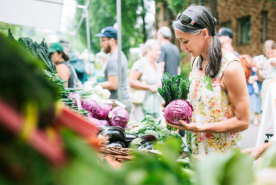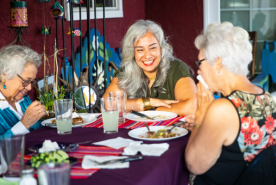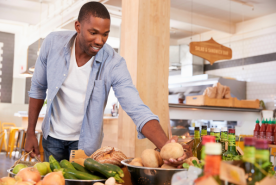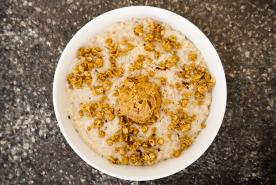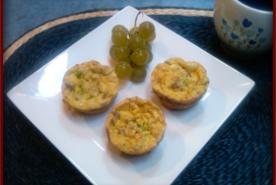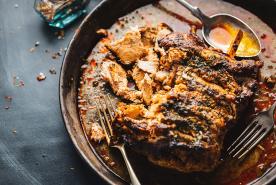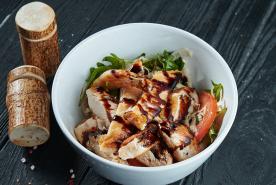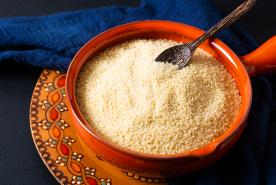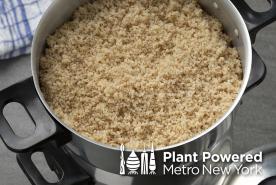Have an emergency meal plan to take care of your health if you miss dialysis. Keep non-perishable food, medications, and essential supplies on hand.
This meal plan is for you to use in case of an emergency or a natural disaster when you may not be able to attend dialysis. It is important to follow a limited diet if you have to miss dialysis. A grocery list and a three-day meal plan for an emergency are attached to this fact sheet. This diet is much stricter than your usual diet. You will need to follow this strict plan to control the build-up of toxins such as potassium, phosphorus, urea and fluids that can be life-threatening to you if you miss several dialysis treatments due to the emergency.
Many things we depend on daily may not be working during an emergency. You may be without a telephone. Water and electricity may be cut off, keeping you from cooking your meals in the usual way. You may need to use cold or shelf-stable foods until the crisis is over. Food in your refrigerator will keep safely for up to 12 hours and in the freezer for one to two days, if these appliances are opened only when meals are prepared. It is best to eat the foods from your refrigerator and freezer first before using your shelf-stable foods. Distilled or bottled water, disposable plates, and utensils should also be kept on hand.
- This diet sheet
- Always have a two-week supply of all medicines and vitamins
- All of the groceries listed in this guide
- Diabetics need to have enough insulin and supplies on hand, including extra batteries for the glucometer
- Emergency phone list with names and phone numbers of your doctor, dialysis unit and the local hospital
- Radio with extra batteries
- Flashlight with extra batteries
- Candles and matches
- Measuring cups and scale
- Plastic forks, spoons, knives, plates, bowls and cups
- Napkins
- Hand operated can opener
- 5 gallons distilled water
- Refrigerator thermometer
- It is very important to follow your diet according to the meal plan given.
- Be careful when eating perishable foods to avoid food poisoning. If a jar or can is opened, do not keep it longer than 4 hours unless refrigerated.
- Use a refrigerator thermometer to know if food is stored at a safe temperature (under 40 degrees F, 5 degrees C). If your refrigerator temperature is over 40 degrees F, food will only be safe for 4 hrs. After that time- throw it away.
- Use disposable plates and utensils. Throw away after use.
- Keep distilled water handy for mixing milk or juice. Mix small amounts of only 4 ounces at a time.
- Limit intake of fluid to 2 cups or 16 ounces per day. Chew gum to help cope with thirst.
- Do not use salt or salt substitute with your meals. Use salt-free foods when possible.
- Avoid high potassium foods. Limit the kinds and portion sizes of fruits and vegetables eaten to those listed in this fact sheet
- If you have diabetes, keep instant glucose tablets, sugar, hard candy, low-potassium fruit juices, or sugared soda pop on hand to treat low blood sugars. Avoid high-potassium fruit juices (orange juice).
Item | Amount (per person) |
Bread/Cereal (use 6-8 servings per day) | |
White Bread | 1 loaf |
Dry cereal, unsalted, sweetened or unsweetened Puffed wheat or rice, shredded wheat | 6 single serve containers or 1 box |
Vanilla Wafers or Graham crackers or Unsalted crackers | 1 box |
Fruits/Juices (limit to 2-4 servings per day) | |
Canned or sealed plastic container: | 12 single serve containers |
| Cranberry and apple juice or Juice boxes or pouches of premixed fruit punch or lemonade or Powdered drink mixes fruit flavored, fruit punch or lemonade | 12 single serve containers or 2 packages or 1 canister
|
Fish/Meat (limit to 3 oz. per day) Low sodium, canned: | |
Tuna, salmon, meat, turkey, chicken Peanut Butter, unsalted | 6 small cans 1 jar |
Milk (limit to 1/2 cup per day) | |
Evaporated milk | 3 small cans |
Dry milk solids | 2 packages |
Sweets (Use as desired to increase calories) | |
Marshmallows | 1 large bag |
Jelly beans, sourballs, hard candies, butter mints | 5 bags total |
Honey | 1 jar |
White sugar | 1 small bag |
Jelly | 1 jar |
Fats (use 6 or more servings per day) | |
Salad or cooking oil | 1 bottle |
Mayonnaise (perishable after opening) | Individual packets or 3 small jars |
Butter/Margarine | 1 pound |
Other | |
Bottled/Distilled water | 5 one gallon jugs |
The sample meal plans given provide about 40-50 grams of protein, 1500 mg sodium, 1500 mg potassium and less than 500 cc or 16 ounces of fluid for each of the three days. You may adjust selections to fit your individual taste. These meal plans are stricter than your normal kidney diet to keep waste products from building up in your blood during the emergency situation. Fluid is limited to less than 500 cc (2 cups or 16 ounces) each day to prevent you from swelling or having shortness of breath. If the disaster should continue for more than three days the meal plan can be repeated, beginning with Day 1.
DAY 1
Breakfast
½ cup milk prepared from dry milk and ½ cup distilled water, or ¼ cup evaporated milk with ¼ cup distilled water
1 single serving of cereal (½ - ¾ cup)
1 Tablespoon sugar
½ cup pineapple (single serving)
Morning Snack
5 vanilla wafers
Honey or jelly as desired on wafers
10 sourballs
Lunch
2 slices white bread
¼ cup low-sodium tuna (open new can daily)
1 tablespoon margarine or mayonnaise (individual packet or open new jar daily)
½ cup pears (single serving)
Powdered drink mix with ½ cup distilled water
Afternoon Snack
6 unsalted crackers
Honey or jelly as desired on crackers
10 jelly beans
Dinner
2 slices white bread
½ cup (2 oz.) low-odium chicken (open new can daily)
2 tablespoons margarine or mayonnaise (individual packet or open new jar daily)
½ cup peaches (single serving)
½ cup cranberry juice (from box or pouch)
Evening Snack
3 graham crackers
Honey or jelly as desired on crackers
10 butter mints
DAY 2
Breakfast
½ cup milk prepared from dry milk and ½ cup distilled water,
or mix ¼ cup evaporated milk with ¼ cup distilled water
1 single serving of cereal (½ - ¾ cup from box)
1 Tablespoon sugar
½ cup mandarin oranges (single serving)
Morning Snack
3 graham crackers
Honey or jelly as desired on graham crackers
10 hard candies
Lunch
2 slices white bread
¼ cup (1 oz.) low-sodium turkey (open new can daily)
1 tablespoon margarine or mayonnaise (individual packet or open new jar daily)
½ cup fruit cocktail (single serving)
Powdered drink mix with ½ cup distilled water
Afternoon Snack
6 unsalted crackers
Honey or jelly as desired on crackers
10 large marshmallows
Dinner
2 slices white bread
½ cup (2 oz.) low-sodium chicken (open new can daily)
2 tablespoons margarine or mayonnaise (individual packet or open new jar daily)
½ cup pineapple (single serving)
½ cup cranberry juice (from box or pouch)
Evening Snack
5 vanilla wafers
Honey or jelly as desired (use on wafers)
10 sourballs
DAY 3
Breakfast
½ cup milk prepared from dry milk and ½ cup distilled water,
or ¼ cup evaporated milk with ¼ cup distilled water
1 single serving of cereal (½ - ¾ cup from box)
1 Tablespoon sugar
½ cup pears (single serving)
Morning Snack
6 unsalted crackers
Honey or jelly as desired on crackers
10 large marshmallows
Lunch
2 slices white bread
2 Tablespoons low-sodium peanut butter
½ cup peaches (single serving)
Powdered drink mix with ½ cup distilled water
Afternoon Snack
3 graham cracker squares
Honey or jelly as desired on crackers
10 butter mints
Dinner
2 slices white bread
½ cup (2 oz.) low-sodium chicken (open new can daily)
2 tablespoons margarine or mayonnaise (individual packets or open new jar daily)
½ cup mandarin oranges (single serving)
½ cup cranberry juice (from box or pouch )
Evening Snack
5 vanilla wafers
Honey or jelly as desired (use on wafers)
10 sourballs
If you would like more information, please contact us.
Acknowledgment: Reviewed by the Council on Renal Nutrition (03/2019)
© 2019 National Kidney Foundation. All rights reserved. This material does not constitute medical advice. It is intended for informational purposes only. Please consult a physician for specific treatment recommendations.



